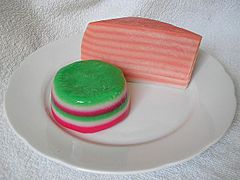Kue lapis facts for kids

Two shapes of kue lapis
|
|
| Alternative names | Kue Pepe Kuih Lapis (Malaysia, Singapore, and Brunei) |
|---|---|
| Type | Kue |
| Course | Dessert |
| Place of origin | Indonesia |
| Region or state | Nationwide |
| Associated national cuisine | Indonesia, Malaysia, Singapore, and Brunei |
| Serving temperature | Room temperature |
| Main ingredients | Rice flour, sugar, coconut milk |
Kue lapis is an Indonesian kue, or a traditional snack of steamed colourful layered soft rice flour pudding. In Indonesian lapis means "layers". This steamed layered sticky rice cake or pudding is quite popular in Indonesia, Suriname (where it is simply known as lapis) and can also be found in the Netherlands through their colonial links. Kue lapis is also very popular in neighbouring Malaysia, Singapore, and Brunei where it is called kuih lapis. Kue lapis was introduced by the Sino-Burmese to Lower Myanmar, where it is known as kway lapay (ကွေလာပေး) or kway lapaysa (ကွေလာပေးစ).
Ingredients and cooking method
This snack usually consists of two alternating coloured layers, thus the name of the cake. The cake is made of rice flour, sago, coconut milk, sugar, salt, and food colouring. Popular food colouring includes green-coloured pandan and red frozen food colouring. It is common to find rainbow layered kue too. This cake is steamed gradually, and layers are subsequently added in alternating order to avoid different colours mixing together. This method will create layered pudding-cake. Kue Lapis has bouncy gelatin-like texture, yet unlike jelly this cake is quite sticky and chewy due to rice pudding content.
Kue lapis is similar to lapis legit or spekkoek, the difference being that lapis legit is a puffy layered cake, made of flour and is baked, while kue lapis is a moist layered pudding, made of rice flour and sago, and is steamed.

